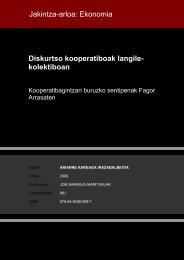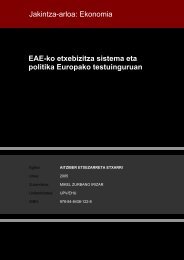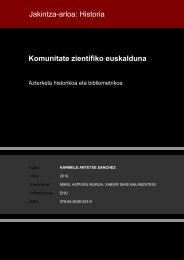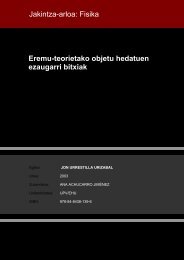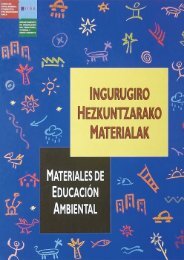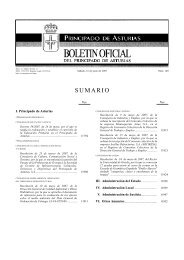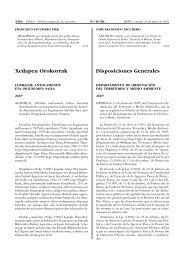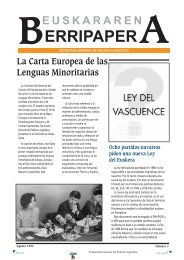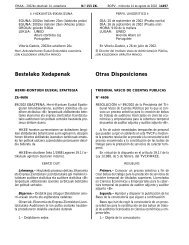Sinterizazio-atmosferaren eragina M graduko (ASP 30 ... - Euskara
Sinterizazio-atmosferaren eragina M graduko (ASP 30 ... - Euskara
Sinterizazio-atmosferaren eragina M graduko (ASP 30 ... - Euskara
Create successful ePaper yourself
Turn your PDF publications into a flip-book with our unique Google optimized e-Paper software.
TABLE V Chemical analysis of M 23 C 6<br />
Steel Particle Mo V Cr Fe Co<br />
(atomic %)<br />
trial atmosphere . This seems to be due to the fact that<br />
in the industrial atmosphere rich in nitrogen the MC<br />
carbides are transformed to MX carbonitrides and the<br />
possible transformation on cooling of the liquid to<br />
MX and austenite, which happens when MC carbide<br />
is formed, disappears or is shifted to much higher<br />
temperatures . This type of MC eutectic carbide was<br />
neither observed in T1, due to low V content of the<br />
steel . The presence of M 6 C eutectic carbides both<br />
under vacuum and industrial atmosphere seems to<br />
define the limit of adecuated sintering . The addition of<br />
carbon or the introduction of nitrogen through the<br />
atmosphere does not affect strongly the temperature<br />
at which the first M 6 C appears in each steel . But<br />
because the addition of carbon - in all cases - and<br />
the introduction of nitrogen - in some cases - decrease<br />
the optimum sintering temperature, the increase<br />
of concentration of both elements in the steel<br />
enlarge the sintering "gate" .<br />
The composition and morphology of the needle<br />
type eutectic carbide found in the T15 and T42 after<br />
important oversinterings in vacuum, is similar (adding<br />
W + Mo) to that found for steel M2 [16,17] and M42<br />
[18] and identified as M 2C. Several works [17, 19, 20]<br />
have shown that M 2 C carbides are unstable and decompose<br />
during the cooling to M 6C and MC . In this<br />
work the cooling rate was very high and that could<br />
explain why this decomposition did not take place . To<br />
confirm this hypothesis, a T15 + 0 .2%C sample was<br />
cooled slowly in the furnace (20 K h - ') after an oversintering<br />
of 25 K . For this oversintering needle shape<br />
eutectic carbides were observed after the normal cooling<br />
of 250 K min - ' . In the metallographic analysis of<br />
the specimen after the slow cooling, this kind of needle<br />
shape eutectic carbides could not be found, but the<br />
coprecipitation of M 6C and MC carbides, indicating<br />
the possible transformation on cooling of M 2 C to<br />
M 6 C and MC as indicated by Fredricksson et al . [17] .<br />
A similar situation has been recently observed by<br />
Urrutibeaskoa et al. [14] in a M2 high speed steel .<br />
This needle type eutectic carbide was not observed in<br />
samples oversintered even by 50 K in the industrial<br />
atmosphere. It seems that the presence of nitrogen in<br />
the specimens sintered under the industrial atmosphere<br />
avoids the formation of this eutectic carbide, as<br />
has been observed by Steven [19] that by increasing<br />
the nitrogen content in M7 and M2 steels the formation<br />
of M 2C carbides is difficult .<br />
W W + Mo Fe + Co<br />
T15 (this work) El 9 19 25 23 0 24 31 23<br />
T15 + N (this work) El 7 8 25 47 1 12 19 48<br />
T15 + N M 23 C 6 [21] 2 7 32 52 2 5 7 54<br />
T15 + N C .G . [21] 2 11 27 55 0 5 7 55<br />
T15 + N EI [21] 4 6 25 58 0 6 10 58<br />
T42 (this work) El 18 13 24 34 3 9 27 37<br />
T42 + N (this work) El 20 10 28 <strong>30</strong> 1 10 <strong>30</strong> 31<br />
T42 M 23 C6 [22] 1 4 54 39 0 2 3 39<br />
T42 C. cut [23] 14 8 18 49 5 6 20 54<br />
The eutectic carbide called type I in the present<br />
work, found at the optimum sintering temperature<br />
and in some case 25 K below the optimum [18], has<br />
been also found by other authors in different high<br />
speed steels [15, 21, 22] . In Table V are compared the<br />
chemical composition of this type of eutectic carbide<br />
with other of the same kind found in the literature .<br />
This carbide type being rich in Cr and Fe could be of<br />
M 23C6 type . In Table V are also included the chemical<br />
analysis of some M 23C6 also reported in the literature,<br />
being the composition of this carbide similar to the<br />
type I found in the present work .<br />
5 . Conclusions<br />
1 . After cooling from the optimum sintering temperature<br />
in vacuum, primary carbides type M 6 C were<br />
present in all the steels analysed and MC, although<br />
present in T42 and T15, was not found in TI steel .<br />
2 . After sintering in the industrial atmosphere the<br />
same M 6 C primary carbides are present, but the<br />
MC transform to a carbonitride MX of small size .<br />
3 . In all steels analysed, after sintering at the optimum<br />
temperature, either in the atmosphere or in vacuum,<br />
small amounts of an eutectic rich in Cr and Fe<br />
has been found .<br />
4 . Oversintering under vacuum at progressive higher<br />
temperatures produces eutectic carbides type :<br />
M 6 C, needle shape and MC. These last two carbides<br />
are not present when the sintering takes place<br />
in the industrial atmosphere .<br />
5 . In all steels, sintered at the same medium, the<br />
chemical composition of the different type of<br />
carbides are the same if W + Mo and Fe + Co are<br />
added in atomic % .<br />
.<br />
References<br />
1 . F . L . JAGGER and W . J . C . PRICE,<br />
(Suppl . 1) (1971) 407-28 .<br />
Powder Metall . 14<br />
2 . A . S . WRONSKI, L . B . HUSSAIN AL-YASIRI and F . L .<br />
JAGGER, ibid . 22 (1979) 109-18 .<br />
3 . C . S . WRIGHT and R . S<br />
3389-98 .<br />
IRANI, J. Mater . Sci . 19 (1984)<br />
4 . C . S . WRIGHT, A . S . WRONSKI and M . M . REBBECK,<br />
Met . Technol . 11 (1984) 181-8 .<br />
5 . Internal report, University of Bradford, Engineering Materials<br />
Group (1987) .<br />
6 . Unpublished work, University of Bradford, Engineering<br />
Materials Group (1987) .<br />
2033



